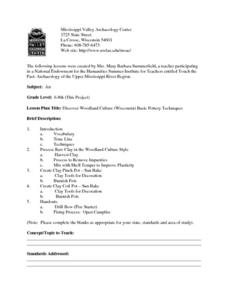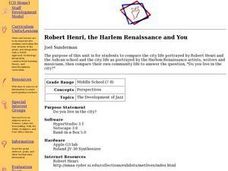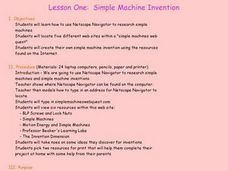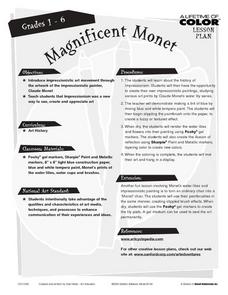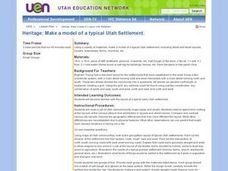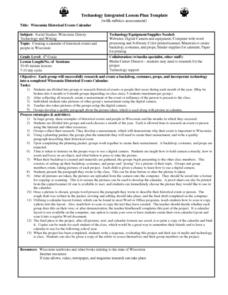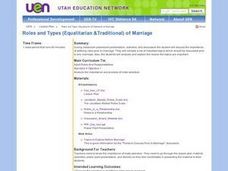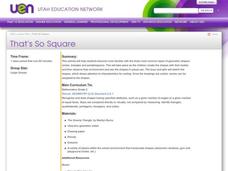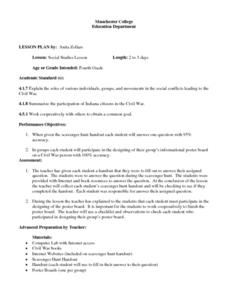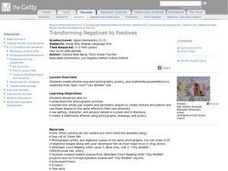Curated OER
Mapping an Artifact
Students copy a present day artifact onto graph paper. In groups, they decide the scale of the drawing and create the picture using specific graphing points. They are also given photographs in which there are no graphing points and they...
Curated OER
Discover Woodland Culture: Wisconsin Basic Pottery Techniques
Students take a field trip to a local woodland to find pieces of clay. Once they are back in the classroom, they dry the clay throughly and turn it in to clay slip. They watch a PowerPoint presentation on basic art terms and create...
Curated OER
A Trip through the Panama Canal
Pupils explore the Panama Canal. They study its history, location, reasons for being built, ownership, and so forth. They create presentations that demonstrates what students learned through their research activities.
Curated OER
Christmas Handprint Wreath and Other Holiday Hand Crafts
Students trace their hands and use the prints to create Christmas wreaths. They explore the history and development of the symbolism behind the Christmas wreath.
Curated OER
What a Site!
Fourth graders are introduced to how to properly create a grid site. In groups, they use Cartesian coordinates to establish the boundaries for the grid and photograph the location of artifacts. They exchange their photos with another...
Curated OER
Robert Henri, the Harlem Renaissance and You
Students examine the artwork of Robert Henri. Using his pieces, they compare and contrast it to the works during the Harlem Renaissance. They create a HyperStudio project showing the Ashcan School of Art with music accompanying the...
Curated OER
Simple Machine Invention
Students access the Internet and research simple machines. They locate five different web sites within a simple machines web quest and then create their own simple machine invention using the resources found on the Internet.
Curated OER
Successful Deaf Leaders in Government
Learners create a "Who's Who" compilation of local, state, national and international leaders that advocate, introduce legislation, and lobby for the deaf. They use internet research to create a catalog of biographies and then conduct a...
Curated OER
Math: a World of Symmetry
Students expand their knowledge of quadrilaterals and identify basic symmetrical forms. Over three weeks, they explore the math, application, and discussion of symmetry. After conducting Internet research, students create symmetrical...
Curated OER
Magnificent Monet
Learners research the water lily paintings of Claude Monet and the impressionistic art period. They create their own impressionistic art works and display them in the classroom.
Curated OER
Tri this Angle!
First graders draw and describe various types of polygons. they investigate their own environments for examples of polygons. After reading the book, The Greedy Triangle, they discuss everyday objects that are polygons. They create shape...
Curated OER
Heritage: Make a Model of a Typical Utah Settlement
Fourth graders examine the different types of settlements used in Utah. They take a community map of Utah past and present and compare the two. They create a model of the early types of settlements used by pioneers in Utah.
Curated OER
The Art Miles Mural Project
Students create over twelve hundred miles of themed murals for an art project. They discuss what they want their theme to be and practice drawing the pictures before painting the mural.
Curated OER
Windows, Doors, Roofs, and Housing Styles
Students identify window treatments and factors that lead to their selection. They study different types of windows and doors and a windows and doors project. They use their knowledge of styles to create an exterior drawing of a home.
Curated OER
Wisconsin Historical Events Calendar
Fourth graders create a calendar of historical events and people in Wisconsin. They select a month of the year and research events and people using the Internet and other resources. They collect their research and create a reencactment...
Curated OER
Roles and Types (Equalitarian &Traditional) of Marriage
Students investigate the concepts related to increasing comprehension of types of marriages in different cultures. They conduct research using a variety of resources and create a list of important topics. Students use the information in...
Curated OER
That's So Square
Second graders are introduced to circles, triangles and parallelograms. As a class, they create the shape with their bodies and are shown the shapes in their actual size. To end the activity, they sketch each shape and identify their...
Curated OER
Geography: I Spy Environments
Fourth graders examine nature paintings from a Utah museum for their physical characteristics. In small groups, they observe museum postcards and discuss the season, precipitation, temperature, and geometric shapes pictured. Focusing...
Curated OER
Color Story
Students listen to a teacher-created story and practice using color words with a word processing program. This lesson has a video explanation and an AppleWorks example of a teacher-created story.
Curated OER
Civil War Participants
Fourth graders use Internet and book resources to complete a scavenger hunt in which they must find information regarding people involved in the Civil War. Then they use information they found on the scavenger hunt to create a poster of...
Curated OER
Fossil Footsteps
Fourth graders create their own dinosaur tracks using clay. In addition, 4th graders compose a story about the dinosaur / animal who created the tracks. They study photographs of dinosaur tracks before beginning.
Curated OER
Giants of the Past
Learners listen to the book, The Mysterious Giant of Barletta, and create paper sculptures based on ancient Greek and Roman statues in the Getty Museum. They write narrative stories told from the viewpoints of their sculptures.
Curated OER
Transforming Negatives to Positives
Students create double-exposed photographs, poetry, and multimedia presentations to celebrate their Open Court "City Wildlife" unit.
Curated OER
"Attack A Cell, Any Cell" Disease Unit
Seventh graders use the Internet to gather information about a disease. They also discuss in groups how diseases are a worldwide problem and brainstorm ideas they can help. They create an informational packet on the disease they researched.

